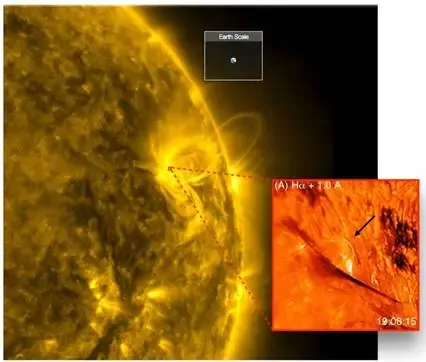Could Tiny Loops in the Solar Corona Reveal the Sun's Hidden Explosive Secrets?

Synopsis
Key Takeaways
- Discovery of tiny plasma loops in the Sun's corona.
- These loops are crucial for understanding solar magnetic energy.
- Utilized advanced telescopes for high-resolution imaging.
- Study published in The Astrophysical Journal.
- Future research may be conducted with the proposed National Large Solar Telescope.
New Delhi, July 7 (NationPress) Astronomers affiliated with the Indian Institute of Astrophysics (IIA), a self-sufficient entity under the Department of Science and Technology (DST), have made a significant discovery by uncovering tiny plasma loops that could unlock some of the Sun's greatest enigmas.
These loops, which are diminutive and ephemeral, have remained concealed until now; however, they may provide insight into the ways the Sun manages and releases its magnetic energy, according to the researchers from IIA.
The coronal loops, located within the Sun’s outer layer, are stunning arc-like formations of hot plasma that emit a glow at temperatures exceeding one million degrees.
These miniature loops span approximately 3,000 to 4,000 kilometers in length (about the distance from Kashmir to Kanyakumari).
Despite their length, they measure less than 100 kilometers in width, posing challenges for observation. Their presence in the lower strata of the Sun's atmosphere meant they were largely overlooked by previous telescopes.
To observe these elusive structures, astronomers at IIA employed high-resolution imaging and spectroscopy techniques.
"These tiny loops have a short lifespan, lasting only a few minutes, which makes them incredibly difficult to study and understand their origins," explained Annu Bura, a PhD student at IIA.
"Though small, these loops contribute significantly to our understanding of the Sun, offering a fresh perspective on how magnetic energy is accumulated and released within the solar atmosphere on a smaller scale," she noted.
Published in The Astrophysical Journal, the research team utilized advanced telescopes to explore these diminutive coronal loops. They integrated data from the Goode Solar Telescope at BBSO, NASA's Interface Region Imaging Spectrograph (IRIS), and the Solar Dynamics Observatory (SDO) to study these loops across various wavelengths.
"Our multi-instrument observations enabled us to analyze the loops not only in visible light but also in ultraviolet and extreme-ultraviolet wavelengths, showcasing their behavior across the chromosphere, transition region, and corona, the various layers of the Sun's atmosphere," Bura stated.
The H-alpha spectral line from hydrogen atoms is crucial for probing the solar chromosphere, just above the Sun's visible surface.
The team found that in the longer wavelength part of this line, these loops appeared as bright, delicate arcs akin to coronal loops, observed clearly for the first time.
Moreover, to assess the plasma temperature within these loops, the team employed a sophisticated method known as Differential Emission Measure analysis.
Results indicated plasma temperatures exceeding several million degrees, hot enough to be visible in the extreme ultraviolet spectrum captured by SDO's Atmospheric Imaging Assembly.
The proposed 2-meter aperture National Large Solar Telescope (NLST), intended to be situated near Pangong Lake in Ladakh, could uncover even more secrets hidden within these small-scale solar phenomena, the team suggested.








